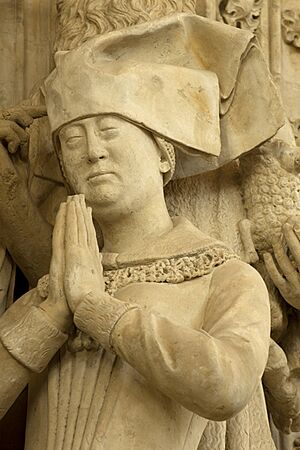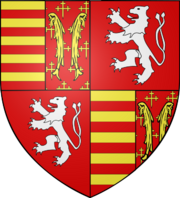Maria of Looz-Heinsberg facts for kids
Quick facts for kids
Mary of Looz-Heinsberg
|
|
|---|---|
| Countess Consort of Nassau-Siegen | |

Countess Mary of Nassau-Siegen, nee Lady of Looz-Heinsberg, detail of the epitaph in the Grote Kerk in Breda. Photo: Paul M.R. Maeyaert, 2011.
|
|
| Coat of arms |  |
| Full name |
Mary of Looz-Heinsberg
|
| Native name | Maria van Loon-Heinsberg |
| Born | 1424 |
| Died | 20 April 1502 |
| Buried | Grote Kerk, Breda |
| Noble family | House of Looz |
| Spouse(s) | John IV of Nassau-Siegen |
| Issue Detail |
|
| Father | John II of Loon-Heinsberg |
| Mother | Anne of Solms |
Lady Mary of Looz-Heinsberg (born 1424, died April 20, 1502) was a noblewoman from the House of Looz. When she married, she became the Countess of Nassau-Siegen.
Contents
Mary's Life and Family
Early Life
Mary was born in 1424. She was the oldest daughter of Lord John II of Looz-Heinsberg and his second wife, Countess Anne of Solms. Mary had an older half-brother named John, who became a Prince-bishop in Liège.
Marriage and New Home

On February 7, 1440, Mary married Count John IV of Nassau-Siegen. John was the oldest son of Count Engelbert I of Nassau-Siegen.
After their marriage, Mary and John lived in a house called De Herberghe in Breda. Later, they moved into Breda Castle. From there, John managed his lands in the Netherlands.
When John's father died in 1442, John and his brother Henry II became Counts of Nassau-Siegen. In 1447, the brothers divided their lands. John received the lands in the Netherlands and parts of the County of Vianden and Herborn.
Faith and Devotion
Mary was known for being a very religious Catholic. In 1449, Mary and John helped move a special holy object called the Sacrament of Niervaert to the Grote Kerk in Breda. This holy object was a miraculous host. Its story is told in an old play and shown in a special artwork from around 1535.
Life at Dillenburg Castle
After his brother Henry died in 1451, John inherited even more lands. He had to travel a lot to manage all his properties. When he was in his county, he often stayed in Siegen or Dillenburg.
John decided to make Dillenburg Castle a more comfortable home for his family. Between 1453 and 1467, he had the castle expanded and rebuilt. In 1464, Mary had a special church chair made for the castle chapel. She also had a shrine built for the Blessed Sacrament there.
In 1469, Mary asked for rosemary and other herbs to be brought to Dillenburg from the Rhine area. This was probably because of the plague, a serious illness. This is one of the oldest records of medicines being used in their family's history.
Land Disputes
Through her marriage to John, Mary gained control of several important areas, including Herstal, Vught, Gangelt, Waldfeucht, and the Land of Millen. This meant John owned a quarter of the Duchy of Jülich.
This led to a disagreement with John's distant relative, John II of Nassau-Saarbrücken. The dispute was complicated and involved the Emperor and other powerful dukes. Eventually, the issue was settled in 1499. Mary's oldest son, Engelbert II, traded his share of some lands for the city of Diest and the lands of Zichem and Zeelhem.
Mary as a Widow
After John died, Mary became a widow. In 1476, she founded Vredenburg Abbey in Bavel. In 1478, she also started a convent for the Grey Sisters. She also supported the Saint Catherinadal Abbey in Breda. In 1486, she gave a lot of money to Saint Wendelin's chapel in Breda.
Mary wrote her will and testament in 1501. She asked that 100 malters of grain from her estate be given to the poor people of Dillenburg. She died in Siegen on April 20, 1502, and was buried in the Grote Kerk in Breda.
Children of Mary and John
Mary and John had six children:
- Anne (born 1440 or 1441 – died April 5 or 8, 1514). She married Duke Otto II and later Count Philip the Elder.
- Joanne (born 1444 – died May 1468). She married Count Philip I of Waldeck-Waldeck.
- Ottilie (born around 1445 – died April 22, 1495). She became a nun. She was the first prioress of Vredenburg Abbey in Bavel.
- Adriana (born February 7, 1449, in Breda – died January 15, 1477). She married Count Philip I of Hanau-Münzenberg.
- Count Engelbert II the Illustrious (born May 17, 1451, in Breda – died May 31, 1504, in Brussels). He took over his father's lands in the Netherlands. He married Margravine Cimburga of Baden.
- Count John V (born November 9, 1455, in Breda – died July 30, 1516, in Dillenburg or Siegen). He took over his father's lands in Nassau-Siegen and Diez. He married Landgravine Elisabeth of Hesse-Marburg.
Images for kids
-
Ottilie of Nassau-Siegen (around 1445–1495). A portrait by master Sommeren, 1681. Located at Saint Catharinadal Abbey, Oosterhout.
-
Count Engelbert II the Illustrious of Nassau-Breda (1451–1504). A portrait by the Master of Portraits of Princes, 1487. Located at the Rijksmuseum, Amsterdam.







